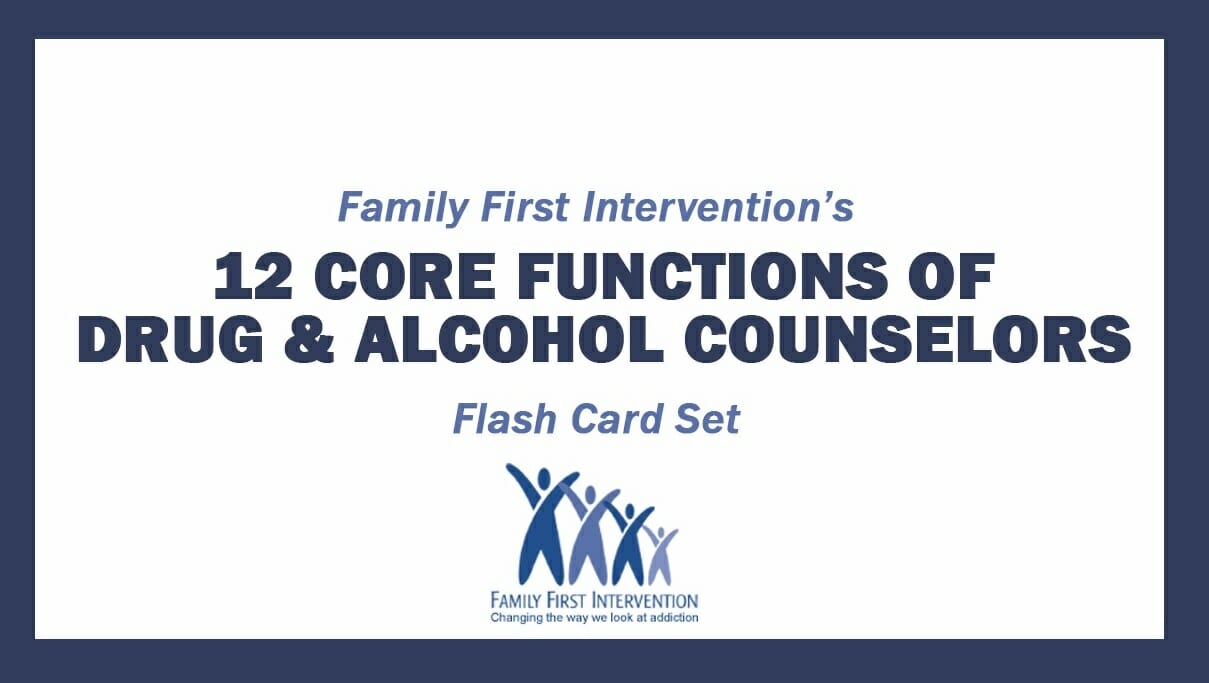Search by category, archive or keyword

Drug and alcohol counselors may be the only chance some addicts have toward a life free from substance abuse. The counselors serve as leaders and supporters, even when no one else does. They impart knowledge and help addicts build a specific plan to overcome dependency based on individual needs. Without drug and alcohol counselors, many would never be free from their addictions.
Drug and alcohol counselors work in a delicate environment where their words can profoundly affect the lives of their clients. Each professional must perform 12 different core functions to be effective and successful.
We’re going to look at the following core functions:
- Patient screening
- Patient Intake
- Patient orientation
- Patient assessment
- Treatment planning
- Counseling
- Case management
- Crisis intervention
- Patient Education
- Referral
- Record-keeping and reporting
- Cross-consultation
 Patient Screening
Patient Screening
Counselors must take a variety of factors into account when deciding to admit a potential client for treatment. The screening function is the first step toward a client receiving help, so it’s crucial for counselors to use the right diagnostic criteria. They must determine whether the individual’s habits constitute abuse or recreational use.
Every counselor needs to be able to describe their criteria and display competence. They can do this by offering specific examples of the way drugs and alcohol are dysfunctional for individual clients. Their judgment is combined with the program’s modality and environment, such as inpatient, residential, pharmacotherapy, outpatient, etc.
Counselors examine the nature of the substance abuse, the psychological functioning of the individual, physical condition, motivation, previous treatment, support resources, and more.
Agencies Have Different Requirements
Eligibility requirements differ between agencies and programs. Criteria usually examine the patient’s age, gender, legal status, income, and more. If a counselor deems an individual eligible for treatment, but he/she does not fit the parameters of the program, the professional should be able to suggest an alternative location.
The global screening criteria for drug and alcohol counselors include all of the above, plus familiarity with and adherence to laws and regulations. Counselors should be familiar with local, state, and federal policies regarding their services.
 Patient Intake
Patient Intake

After the initial assessment, the counselor is required to fill out all the documents and examine the technical aspects of admitting the patient. Although this step is simpler than the first, it can be stressful and time-consuming depending on the volume of paperwork and process of the treatment facility.
Counselors must sign consent forms when gathering information from or providing it to outside sources. The consent forms are a legal step that protects the confidentiality of the patient. It is critical for the counselor to understand the process and guidelines fully for admittance.
 Patient Orientation
Patient Orientation
After screening and admission, the patient will be added to the program and oriented to the goals and nature of the treatment. Everyone must be given rules regarding conduct and expectations. They should also be fully educated about the disciplinary actions they may be subject to when rules are broken.
Regulations vary between program types. For example, non-residential treatment options will have service hours for each available treatment. Residential options will include rules about leaving the campus and family visiting hours.
All facilities include regulations about treatment costs, insurance, and client rights. The counselor must examine each of these aspects to properly educate incoming patients and protect them, as well as the establishment itself.
 Patient Assessment
Patient Assessment
Once the patient is admitted to a program and orientated about the specific guidelines of the facility, he/she is assessed by the counselor. This procedure involves one-on-one meetings between the counselor and the patient. Assessment is one of the most vital parts of treatment because it determines the path each patient will take.
During the assessment, the counselor will identify the strengths, weaknesses, and problems of each patient. The counselor will also evaluate the patient’s mental state to determine the best and most effective course of treatment.
Assessment Steps
Identifying Information Obtaining Methods – The counselor needs to approach the patient correctly to help ensure an exchange of reliable information.
Gathering Information – Patient history includes, but is not limited to, personal trauma, alcohol/drug abuse, mental health history, and other addictive habits like gambling.
Completing the Evaluation – This can be a lengthy process, but it’s crucial to determine the proper method of treatment.
Continuing Evaluation – Assessments must be done regularly during the duration of the patient’s stay. Treatment can be changed depending on the progress of the patient and the effectiveness of current methods.
 Treatment Planning
Treatment Planning
Once the patient is fully assessed and the best treatment types are determined, treatment planning begins. This process takes broad ideas and turns them into specific tactics and plans to fit the patient’s needs.
The counselor must determine the rank of the problems and establish goals. Both long-term and short-term goals are set for every patient to take care of the most severe problems and work toward rehabilitation. The counselor needs to properly explain treatment goals and assessment results to every patient.
Once the problems are uncovered and goals set, the counselor works with the patient to identify treatment methods. It’s important to give an approximate timeline, if possible, and inform the patient about what his/her future at the facility includes. All treatment language must be intelligible for the individual so he/she knows what every aspect truly means.
 Counseling
Counseling

Counseling is part of every good treatment facility. Different programs and locations have different treatment types. Many offer individual and group treatment plans.
In this step, counselors work to assist patients and families in achieving objectives. They explore problems, ramifications, feelings, attitudes, and more.
The drug and alcohol counselor must select the proper counseling type, apply techniques to assist the patient (or family/group), continue individualized counseling, offer therapeutic advice, reach solutions, and implement the treatment plan.
 Case Management
Case Management
This portion of treatment is a broad section. It refers to activities that bring people, services, and agencies together in a predetermined framework of action. These methods are necessary to establish the short-term and long-term goals of the patient.
Global criteria for case management includes coordinating client care services and explaining the care management activities to the client. Again, it’s imperative to help the patient understand the methods and goals of the program.
 Crisis Intervention
Crisis Intervention
Even with the best treatment plans and facilities, drug and alcohol rehab isn’t an easy process. Every patient will likely experience acute emotional and physical distress at some point, including recovery issues or drug relapse.
Aspects of Intervention
Recognize the specific crisis. To provide proper treatment, the counselor must examine specific elements of the situation, particularly if it involves physical distress.
Set an immediate course of action. Depending on the severity of the crisis, it could be potentially harmful to the patient and recovery efforts. Effective counselors need to take fast action to prevent the situation from worsening.
Utilize a crisis to change the treatment plan. After the event, the counselor must develop a plan to help prevent recurring situations.
 Patient Education
Patient Education
Counselors must continue to provide information to their patients throughout the duration of treatment. Both formal and informal processes are used to keep patients educated and up-to-date about treatments, discoveries, progress, and other relevant factors.
 Referral
Referral
In some cases, the needs cannot be met by the counselor or agency. When such a situation arises, the counselor must provide relevant information and advice for the patient.
The counselor must identify which services the facility cannot meet and determine if supplemental assistance can be offered without leaving or un-enrolling from the facility. The counselor can also take advantage of community resources and support systems.
One important part of the referral is to adhere to applicable laws. Local, state, and federal regulations apply when it comes to patient confidentiality.
 Record-Keeping and Reporting
Record-Keeping and Reporting
The results of treatment and assessments must be carefully documented to track progress and develop plans for the patient’s future. Reports, notes, discharge summaries, and other types of information must be kept confidential but properly tracked.
 Cross-Consultation
Cross-Consultation
The final function of a counselor is to communicate with other professionals. Client treatment and services can benefit from in-house and outside resources. The goal of cross-consultation is to ensure the highest quality, most comprehensive care.
Counselors are a crucial part of every treatment facility. These 12 core functions are difficult to master, but they must be considered for every patient. When all of the goals are met, patients are able to recover properly and regain their lives.

CLICK THE LINK BELOW FOR YOUR
FREE DOWNLOAD:
Free 12 Core Steps of Addiction Flash Cards
Published On September 20, 2013
Accuracy Reviewed February 25, 2022
An intervention is not about how to control the substance user; it is about how to let go of believing you can.
“The most formidable challenge we professionals face is families not accepting our suggested solutions. Rather, they only hear us challenging theirs. Interventions are as much about families letting go of old ideas as they are about being open to new ones. Before a family can do something about the problem, they must stop allowing the problem to persist. These same thoughts and principles apply to your loved one in need of help.”
Mike Loverde, MHS, CIP



